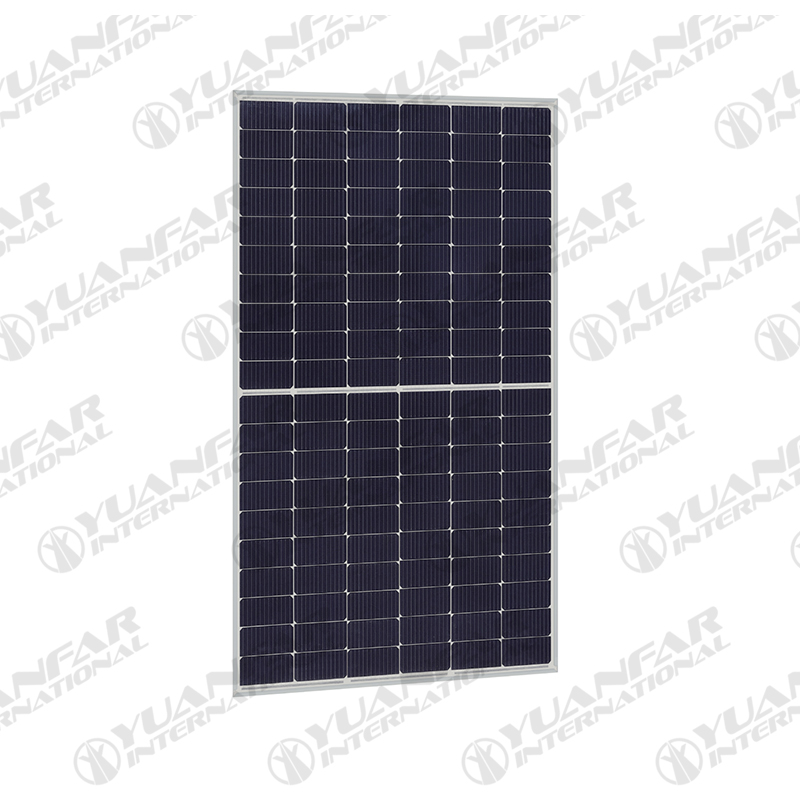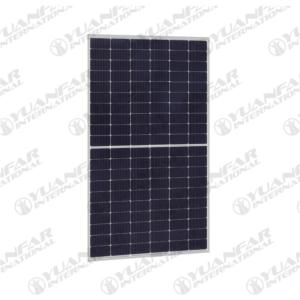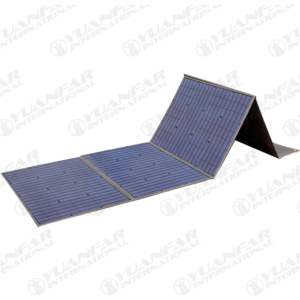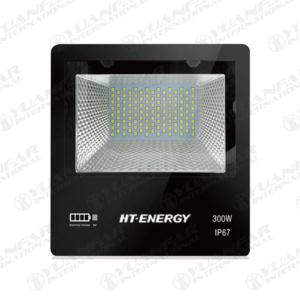HT60-156M-MC Half Cut Cell Solar Panel
- Product Details
- Company Profile
MBB The optimized number and width of main gate lines, Maximize the light receiving area of components and Reduce component power consumption.Designed for high voltage systems of up to 1500 VDC, increas- ing the string length of solar systems and saving on BoS costs.
HT60-156M-MC / HT60-156M(V)-MC series PV modules are composed of 120 pieces helf-cut Mono perc solar cells, and its can be 325W/330W/335W/340W/345W power output. Moreover, MBB The optimized number and width of main gate lines, Maximize the light receiving area of components and Reduce component power consumption. Also, it is designed for high voltage systems of up to 1500 VDC, increas- ing the string length of solar systems and saving on BoS costs. Its module efficiency can be 20.4%, and its main market usually is North America and Europe.
Engineering Drawing

Electrical Charateristricts
Module | HT60-156M-MC / HT60-156M(V)-MC | ||||
Maximum Power at STC(Pmax) | 325W | 330W | 335W | 340W | 345W |
Open-Circuit Voltage(Voc) | 40.3V | 40.4V | 40.5V | 40.6V | 40.7V |
Short-Circuit Current(Isc) | 10.61A | 10.74A | 10.87A | 11.00A | 11.14A |
Optimum Operating Voltage (Vmp) | 33.9V | 34.1V | 34.3V | 34.5V | 34.7V |
Optimum Operating Current(Imp) | 9.60A | 9.69A | 9.78A | 9.87A | 9.96A |
Module Efficiency | 19.3% | 19.6% | 19.9% | 20.1% | 20.4% |
Power Tolerance | 0 ~ +5W | ||||
Maximum System Voltage | 1000V / 1500V DC(IEC) | ||||
Maximum Series Fuse Rating | 15A | ||||
Operating Temperature | -40 °C to + 85 °C | ||||
*STC:Irradiance 1000W/m2,module temperature 25, AM=1.5
Optional black frame or white frame module according to customer requirements
NOCT
Module | HT60-156M-MC / HT60-156M(V)-MC | ||||
Maximum Power | 241W | 244W | 248W | 252W | 256W |
Open Circuit Voltage (Voc) | 38.1V | 38.2V | 38.3V | 38.4V | 38.5V |
Short Circuit Current (Isc) | 8.57A | 8.67A | 8.78A | 8.88A | 8.99A |
Maximum Power Voltage (Vmp) | 32.0V | 32.2V | 32.4V | 32.6V | 32.8V |
Maximum Circuit Current (Imp) | 7.53A | 7.58A | 7.65A | 7.73A | 7.80A |
NOCT | 45°C±2°C | ||||
*NOCT:Irradiance 800W/m2,ambient temperature 20°C,wind speed 1 m/s
I-V Curves

Mechanical Characteristics
Solar Cells | Monocrystalline 158.75 × 79.375mm |
No.of Cells | 120 (6 × 20) |
Dimensions | 1684mm ×1002mm×35mm |
Weight | 19.0kg |
Front Glass | High transmission tempered glass |
Frame | Anodized aluminium alloy |
Junction Box | IP67 |
Cable | 4mm2 (IEC) Length: 900mm |
Connectors | MC4/MC4 Compatible |
Packaging Configuration | 30pcs / box, 780pcs / 40'HQ Container |
Temperature Characteristics
Temperature Coefficient of Pmax | γ (Pm) | -0.39%/K |
Temperature Coefficient of Voc | β (Voc) | -0.29%/K |
Temperature Coefficient of Isc | α (Isc) | 0.049%/K |
Warranty
10-year product warranty |  |
25-year warranty on power output | |
Specific information is referred to the product quality guarantee |
1. Are commercial rooftops installed in factories and other commercial rooftops the same as personal home rooftops?
The benefits are different. For distributed photovoltaic power generation, both the state and local governments are given fixed subsidies, so the photovoltaic power income directly receives the impact of the household electricity price level. The industrial and commercial electricity price is 0.8-1.4 yuan per kWh, and the large industrial electricity price is 0.6-0.8. The electricity price for public utilities is 0.5-0.6 yuan per kilowatt-hour, while the electricity consumption for government schools, hospitals, institutions, agriculture and residents is only 0.3-0.5 yuan per kilowatt-hour. The benefits of distributed photovoltaic projects in buildings or different buildings or power users are different, which requires developers to judge and decide whether the project is cost-effective.
2. How to choose the grid connection voltage of distributed photovoltaic grid connection system?
The grid-connected voltage of the distributed photovoltaic system is mainly determined by the installed capacity of the system. The specific grid-connected voltage needs to be determined according to the grid company's access system approval. The general household chooses 220V to connect to the power grid, and the commercial chooses 380V to connect to the power grid.
3. For distributed photovoltaic projects combined with buildings, how to consider the color, light transmission, size and shape of photovoltaic modules?
The color can be selected to be consistent with or similar to the color of the building. For light transmission, the building should be considered for light. Requirements, not only to meet the indoor light requirements, to avoid secondary lighting, but also to make full use of the building space and area, reasonable choice of size and shape, do a good job of balance and optimization, and professional technical design.
4. After installing the distributed photovoltaic system and connecting to the grid, how to distinguish whether the electricity currently used in the home comes from the grid or the solar cell module of your own home?
After the installation of the distributed photovoltaic power generation system is completed, the grid company will carry out the inspection and acceptance of the grid connection. After the acceptance is passed, two electricity meters will be installed in the owner’s house. The amount is measured. The easiest way is to read the electricity meter. As long as the electricity meter at the photovoltaic system ends, the electricity generated by the solar cell module is used.












 Free Member
Free Member 0
0 Chinese
Supplier
Chinese
Supplier


